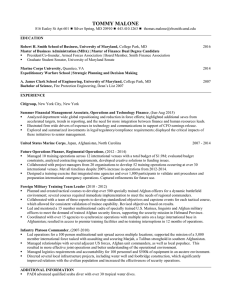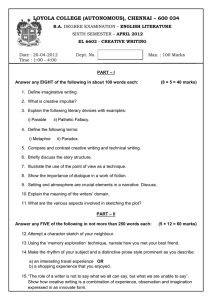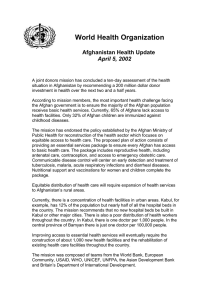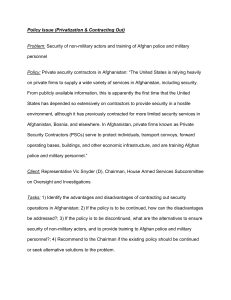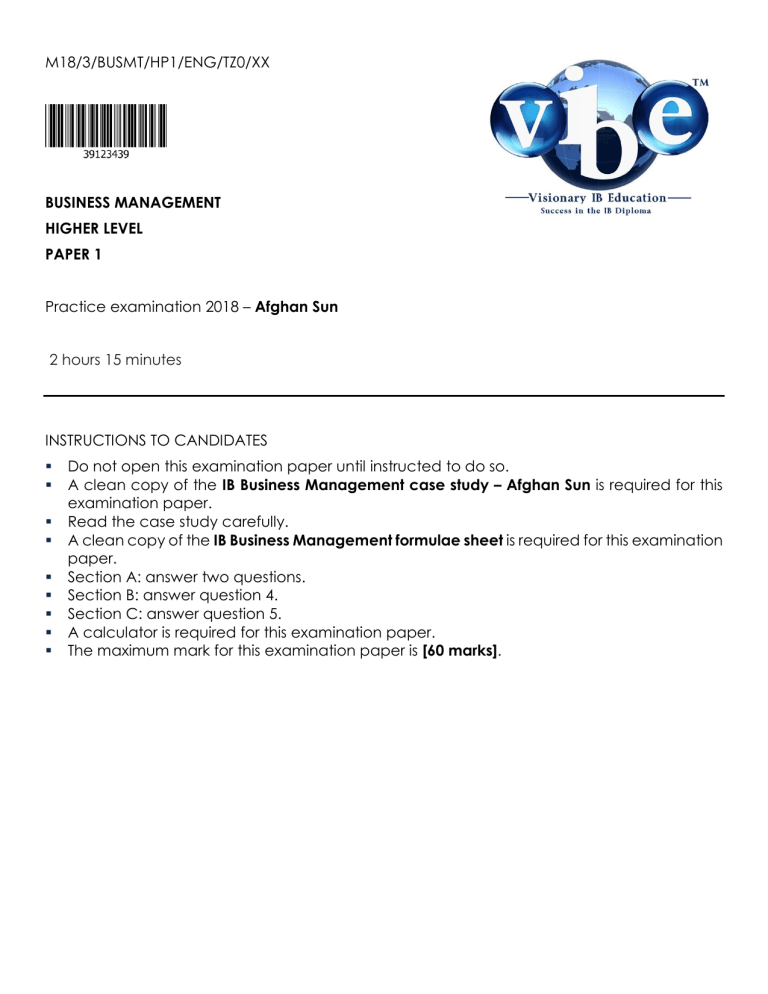
M18/3/BUSMT/HP1/ENG/TZ0/XX BUSINESS MANAGEMENT HIGHER LEVEL PAPER 1 Practice examination 2018 – Afghan Sun 2 hours 15 minutes INSTRUCTIONS TO CANDIDATES ▪ ▪ ▪ ▪ ▪ ▪ ▪ ▪ ▪ Do not open this examination paper until instructed to do so. A clean copy of the IB Business Management case study – Afghan Sun is required for this examination paper. Read the case study carefully. A clean copy of the IB Business Management formulae sheet is required for this examination paper. Section A: answer two questions. Section B: answer question 4. Section C: answer question 5. A calculator is required for this examination paper. The maximum mark for this examination paper is [60 marks]. IB Business Management Higher Level Paper 1 Examination IB Business Management: www.BusinessManagementIB.com SECTION A Answer two questions from this section. QUESTION ONE a. Outline the importance of a contingency plan (line 74) to Afghan Sun. [4 marks] b. With reference to Afghan Sun, distinguish between strategic objectives (line 4) and tactical objectives (line 30). [6 marks] QUESTION TWO a. With reference to Afghan Sun, outline two key functions of management (line 29). [4 marks] b. With reference to Afghan Sun, explain the nature of microfinance providers (line 9). [6 marks] QUESTION THREE a. With reference to Afghan Sun, outline two key features of operating as a private limited company (line 19). [4 marks] b. Analyse how Suchenlin’s leadership style would impact on the objectives of Afghan Sun. [6 marks] Page 2|9 IB Business Management Higher Level Paper 1 Examination IB Business Management: www.BusinessManagementIB.com SECTION B Answer the compulsory question from this section. QUESTION FOUR The following financial information are projections that Su and her team have prepared for Afghan Sun. Table 1: Forecasted financial information for Afghan Sun Forecasted financial information for Afghan Sun Year ending 31st December 2018 Year ending 31st December 2019 Fixed assets $200 000 $230 000 Current assets $50,000 $120,000 Non-current liabilities $50 000 $55 000 Current liabilities $90 000 $40 000 a. Explain why capital expenditure (Table 2 in the case study) would not feature in Afghan Sun’s profit and loss account. [4 marks] b. In Table 2, the cash-flow forecast in the case study, assume “sales costs” are equivalent to costs of goods sold and “other costs” are equivalent to overheads. Using information in Table 1 above and Table 2 in the case study: c. i. Prepare a profit and loss account for the years ending 2019 and 2020 [2 marks] ii. Calculate gross profit margins for the years ending 2019 and 2020 [2 marks] iii. Calculate net profit margins for the years ending 2019 and 2020 [2 marks] iv. Return on capital employed for the year ending 2019 [2 marks] Using information in Table 2, discuss the impact of capital expenditure on Afghan Sun’s liquidity position and strategies the business could have used to improve its cash flow during the forecast liquidity crisis in 2019. [8 marks] Page 3|9 IB Business Management Higher Level Paper 1 Examination IB Business Management: www.BusinessManagementIB.com Additional information There is no additional information in this paper for Sections A and B. Page 4|9 IB Business Management Higher Level Paper 1 Examination IB Business Management: www.BusinessManagementIB.com SECTION C Answer the compulsory question from this section. QUESTION FIVE 5. After considered research regarding the manufacturing of solar power plants, Suchenlin and her advisory team have decided on the following two countries: Option 1, producing in Germany, or Option 2, producing in Afghanistan itself. On a per-unit basis, producing in Afghanistan would be less costly than Germany, but other qualitative factors by-and-large favour manufacturing in Germany. The revised estimated cost of producing the first 2000 solar power units in Afghanistan are: Per unit ($) Total ($) Direct material $90 $180,000 Direct labour $22 $44,000 Additional variable costs $16 $32,000 $16.50 $33,000 $144.50 289,000 Indirect costs (factory overheads - $0.75 per direct labour dollar) However, Suchenlin is now considering a third strategic option: Option 3, outsourcing the manufacture of the entire solar power system to an overseas supplier. The same component can be purchased from market at a price of $105 per unit. If the unit is purchased from market, 50 per cent of the fixed factory overhead will be saved. Whether the solar power system is produced in Afghanistan, Germany, or outsourced, significant distribution costs will be incurred as transportation, installation and agent fees in Afghanistan are estimated to be around $50 per unit. Page 5|9 IB Business Management Higher Level Paper 1 Examination IB Business Management: www.BusinessManagementIB.com Using the case study and the additional information on pages 3 and 5, and items 1-4 below, evaluate what you believe to be the two best options for Afghan Sun to achieve its strategic objectives. You will find it useful to: a. Calculate the cost to buy and the cost to make for option 1, manufacturing in Afghanistan and option 2, outsourcing the solar power system. b. Evaluate outsourcing in the restructuring of production at Afghan Sun. c. Justify the use of cellular manufacturing at Afghan Sun. [20 marks] Page 6|9 IB Business Management Higher Level Paper 1 Examination IB Business Management: www.BusinessManagementIB.com Additional information ITEM 1: THE PAYBACK TIME FOR HOUSEHOLD SOLAR SYSTEMS KEEPS DECREASING \ Source: KPMG report into the economies of household solar power systems (Jan 2018) * Falling prices of solar panels arise from increasing economies of scale as world output continues to grow and solar panel efficiency and production technology improves. Page 7|9 IB Business Management Higher Level Paper 1 Examination IB Business Management: www.BusinessManagementIB.com ITEM 2: AFGHAN SUN – SUMMARY SWOT ANALYSIS Strengths (internal) Weaknesses (internal) ▪ Wealthy owner actively involved ▪ Non-independent CEO ▪ Social benefit objectives ▪ Marketing plan ▪ Motivated employees ▪ Cash flow ▪ Strategic partner in Arif Koomar ▪ ▪ Microfinance to support product purchase Inexperienced management and employees ▪ Financing of the company ▪ Low employee remuneration ▪ Projected profitability ▪ Distribution ▪ Product ideally suited to needs of target market ▪ Inability to achieve economies of scale ▪ Single product ▪ Very low price of product ▪ No research and development team ▪ Strong CSR ▪ Large capital expenditure ▪ Limited market research Opportunities (external) Threats (external) ▪ Expand microfinance business ▪ Changes in technology ▪ Marketing to other consumer segments ▪ Security of product in distribution ▪ Expand product range ▪ Security of supply chain ▪ Technological improvements ▪ Exchange rate volatility ▪ Few remote and rural villages have electricity ▪ Endemic corruption Partnership with government organisations ▪ Difficulty in doing business in Afghanistan ▪ Partnership with NGOs ▪ ▪ Change in legislation (e.g., increased tariffs) ▪ Current and future competitors in the market Page 8|9 IB Business Management Higher Level Paper 1 Examination IB Business Management: www.BusinessManagementIB.com ITEM 3: BREAKING NEWS News item appearing in major newspapers and global media. American antitrust regulators rule that the Ford and Hyundai merger can proceed NEW YORK The presidential election in 2014 that was marred by allegations of massive voter fraud on both sides REUTERS/MILENA BAENSCH Afghanistan’s long-delayed parliamentary and local council elections scheduled for July this year may have to be pushed back for another three months, an election commissioner said on Sunday citing organizational challenges. The parliamentary polls, originally scheduled for July 2015, are seen as dry run for a presidential election in mid-2019 and a test of the progress made by Afghanistan’s Western-backed government towards establishing durable democratic institutions. “We are ready to hold the elections with two or three months’ delay, but the security agencies must tell us whether they are ready,” Wasima Badghisi, deputy head of operations at the Independent Election Commission told Reuters. The problems in organizing the parliamentary vote underline the fragility of the political institutions created in Afghanistan since a U.S.-led campaign brought down the Taliban in 2001. International donor countries have laid heavy emphasis on the need for successful elections this year following a contentious presidential election in Page 9|9
